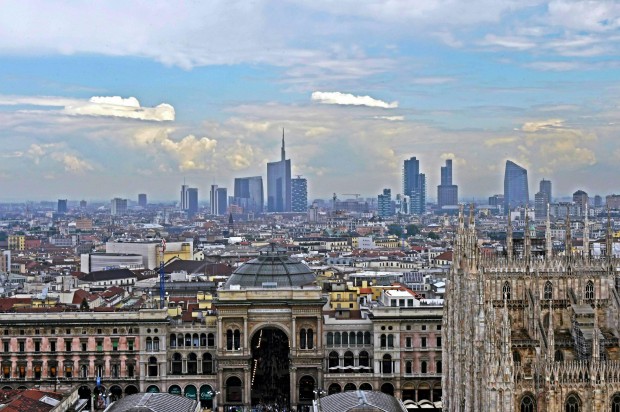Lombardy

Lombardy

Lombardy | |
|---|---|
Region of Italy | |
| Anthem: Lombardia, Lombardia[1] | |
 | |
| Country | Italy |
| Capital | Milan |
| Government | |
| • President | Attilio Fontana (LL–LN) |
| Area | |
| • Total | 23,844 km2(9,206 sq mi) |
| Population (30-04-2019)[2] | |
| • Total | 10,067,494 |
| • Density | 420/km2(1,100/sq mi) |
| Demonym(s) | English:Lombard Italian: Lombardo (man) Italian: Lombarda (woman) |
| Time zone | UTC+1 (CET) |
| • Summer (DST) | UTC+2 (CEST) |
| ISO 3166 code | IT-25 |
| GDP (nominal) | €381 billion (2017)[3] |
| GDP per capita | €38,000 (2017)[3] $51,666 (2016) (PPP)[4] |
| HDI (2017) | 0.901[5] very high· 3rd of 21 |
| NUTS Region | ITC |
| Website | www.regione.lombardia.it [72] |
| The largest resident foreign-born groups on 31 December 2017[16] | |
| Nationality | Population |
| 172,045 | |
| 93,763 | |
| 92,565 | |
| 80,939 | |
| 66,618 | |
| 58,412 | |
| 53,360 | |
| 46,274 | |
| 42,992 | |
| 37,970 | |
| 37,290 | |
| 33,510 | |
| 32,245 | |
| 21,615 | |
| 20,661 | |
| 16,907 | |
| 14,147 | |
| 13,641 | |
| 11,747 | |
| 10,876 | |
| 10,366 | |
| 9,993 | |
| 9,030 | |
Lombardy (/ˈlɒmbərdi, ˈlʌm-/ LOM-bər-dee, LUM-;[6][7] Italian: Lombardia [lombarˈdiːa]; Lombard: Lombardia, Western Lombard: [lũbarˈdiːa], or Lombardéa, Eastern Lombard: [lombarˈde.a]) is one of the twenty administrative regions of Italy, in the northwest of the country, with an area of 23,844 square kilometres (9,206 sq mi). About 10 million people, forming one-sixth of Italy's population, live in Lombardy and about a fifth of Italy's GDP is produced in the region, making it the most populous and richest region in the country and one of the richest regions in Europe.[8] Milan, Lombardy's capital, is the second-largest city and the largest metropolitan area in Italy.
Lombardy | |
|---|---|
Region of Italy | |
| Anthem: Lombardia, Lombardia[1] | |
 | |
| Country | Italy |
| Capital | Milan |
| Government | |
| • President | Attilio Fontana (LL–LN) |
| Area | |
| • Total | 23,844 km2(9,206 sq mi) |
| Population (30-04-2019)[2] | |
| • Total | 10,067,494 |
| • Density | 420/km2(1,100/sq mi) |
| Demonym(s) | English:Lombard Italian: Lombardo (man) Italian: Lombarda (woman) |
| Time zone | UTC+1 (CET) |
| • Summer (DST) | UTC+2 (CEST) |
| ISO 3166 code | IT-25 |
| GDP (nominal) | €381 billion (2017)[3] |
| GDP per capita | €38,000 (2017)[3] $51,666 (2016) (PPP)[4] |
| HDI (2017) | 0.901[5] very high· 3rd of 21 |
| NUTS Region | ITC |
| Website | www.regione.lombardia.it [72] |
| The largest resident foreign-born groups on 31 December 2017[16] | |
| Nationality | Population |
| 172,045 | |
| 93,763 | |
| 92,565 | |
| 80,939 | |
| 66,618 | |
| 58,412 | |
| 53,360 | |
| 46,274 | |
| 42,992 | |
| 37,970 | |
| 37,290 | |
| 33,510 | |
| 32,245 | |
| 21,615 | |
| 20,661 | |
| 16,907 | |
| 14,147 | |
| 13,641 | |
| 11,747 | |
| 10,876 | |
| 10,366 | |
| 9,993 | |
| 9,030 | |
Etymology
The word Lombardy comes from Lombard, which in turn is derived from Late Latin Longobardus, Langobardus ("a Lombard"), derived from the Proto-Germanic elements **langaz + bardaz; equivalent to long beard. Some sources derive the second element instead from Proto-Germanic **bardǭ, barduz ("axe"), related to German Barte ("axe").[9]
During the early Middle Ages "Lombardy" referred to the Kingdom of the Lombards (Latin: Regnum Langobardorum), a kingdom ruled by the Germanic Lombards who had controlled most of Italy since their invasion of Byzantine Italy in 568. As such "Lombardy" and "Italy" were almost interchangeable; by the mid-8th century the Lombards ruled everywhere except the Papal possessions around Rome (roughly modern Lazio and northern Umbria), Venice and some Byzantine possessions in the south (southern Apulia and Calabria; some coastal settlements including Amalfi, Gaeta, Naples and Sorrento; Sicily and Sardinia). The Kingdom was divided between Longobardia Major in the north and Langobardia Minor in the south, which were until the 8th century separated by the Byzantine Exarchate of Ravenna (roughly Romagna and northern Marche, and initially also Emilia and Liguria) and the Papacy (which was initially part of the Exarchate). During the late Middle Ages, after the fall of the northern part of the Kingdom to Charlemagne, the term shifted to mean Northern Italy. (See: Kingdom of Italy (Holy Roman Empire)). The term was also used until around 965 in the form Λογγοβαρδία (Longobardia) as the name for the territory roughly covering modern Apulia which the Byzantines had recovered from the Lombard rump Duchy of Benevento.
Geography
With a surface of 23,861 km2 (9,213 sq mi), Lombardy is the fourth-largest region of Italy. It is bordered by Switzerland (north: Canton Ticino and Canton Graubünden) and by the Italian regions of Trentino-Alto Adige/Südtirol and Veneto (east), Emilia-Romagna (south), and Piedmont (west). Three distinct natural zones can be fairly easily distinguished in Lombardy: mountains, hills and plains—the latter being divided in Alta (high plains) and Bassa (low plains).
Soils

Mount Adamello
The orography of Lombardy is characterised by the presence of three distinct belts: a northern mountainous belt constituted by the Alpine relief, a central piedmont area of mostly pebbly soils of alluvial origin, and the Lombard section of the Padan plain in the southernmost part of the region.
The most important mountainous area is an Alpine zone including the Lepontine and Rhaetian Alps, (Piz Bernina, 4,020 m), the Bergamo Alps, the Ortler Alps and the Adamello massif; it is followed by an Alpine foothills zone Prealpi, which include the main peaks are the Grigna Group (2,410 m), Resegone (1,875 m) and Presolana (2,521 m).
The plains of Lombardy, formed by alluvial deposits, can be divided into the *Alta—*an upper, permeable ground zone in the north and a lower zone—and the *Bassa—*dotted by the so-called line of fontanili, spring waters rising from impermeable ground. Inconsistent with the three distinctions above made is the small subregion of Oltrepò Pavese, formed by the Apennine foothills beyond the Po River.
Hydrography
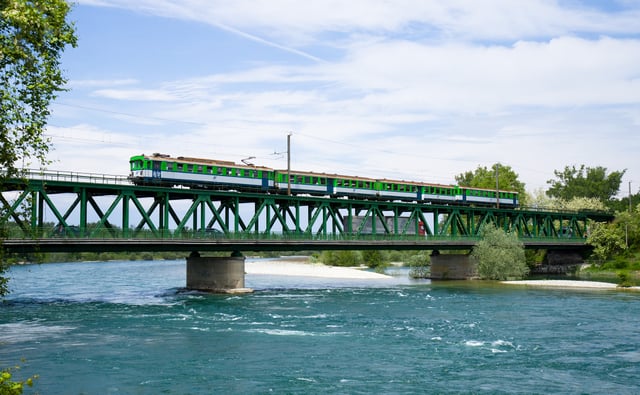
Bridge over the Ticino river
The mighty Po river marks the southern border of the region for a length of about 210 km (130 mi). In its progress it receives the waters of the Ticino River, which rises in the Bedretto valley (Switzerland) and joins the Po near Pavia. The other streams which contribute to the great river are, the Olona, the Lambro, the Adda, the Oglio and the Mincio.
The numerous lakes of Lombardy, all of glacial origin, lie in the northern highlands. From west to east these are Lake Maggiore, Lake Lugano (both shared with Switzerland), Lake Como, Lake Iseo, Lake Idro, then Lake Garda, the largest in Italy. South of the Alps lie the hills characterised by a succession of low heights of morainic origin, formed during the last Ice Age and small barely fertile plateaux, with typical heaths and conifer woods. A minor mountainous area, the Oltrepò Pavese, lies south of the Po, in the Apennines range.
Flora and fauna
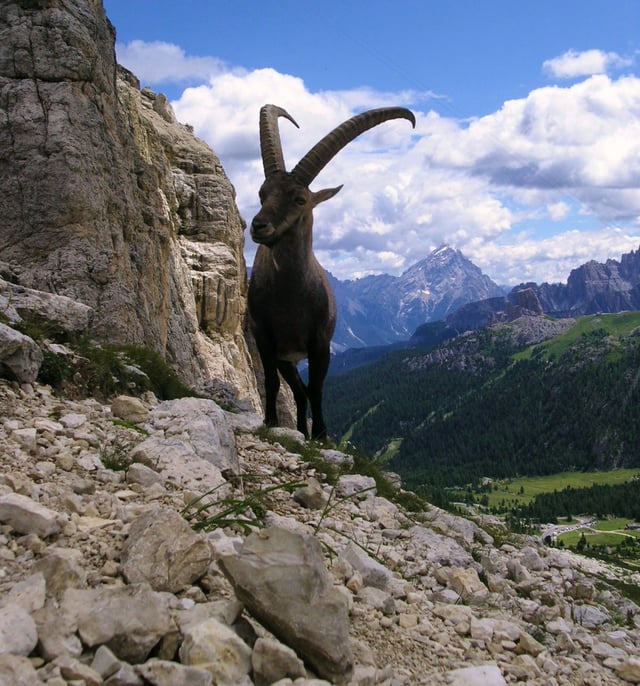
The Alpine ibex (Capra ibex)
In the plains, intensively cultivated for centuries, little of the original environment remains. The most commons trees are elm, alder, sycamore, poplar, willow and hornbeam. In the area of the foothills lakes, however, grow olive trees, cypresses and larches, as well as varieties of subtropical flora such as magnolias, azaleas, acacias. Numerous species of endemic flora in the Prealpine area include some kinds of saxifrage, the Lombard garlic, groundsels bellflowers and the cottony bellflowers.
The highlands are characterised by the typical vegetation of the whole range of the Italian Alps. At a lower levels (up to approximately 1,100 m) oak woods or broadleafed trees grow; on the mountain slopes (up to 2,000–2,200 m) beech trees grow at the lowest limits, with conifer woods higher up. Shrubs such as rhododendron, dwarf pine and juniper are native to the summital zone (beyond 2,200 m).
Lombardy counts many protected areas: the most important are the Stelvio National Park (the largest Italian natural park), with typically alpine wildlife: red deer, roe deer, ibex, chamois, foxes, ermine and also golden eagles; and the Ticino Valley Natural Park, instituted in 1974 on the Lombard side of the Ticino River to protect and conserve one of the last major examples of fluvial forest in northern Italy.
Climate
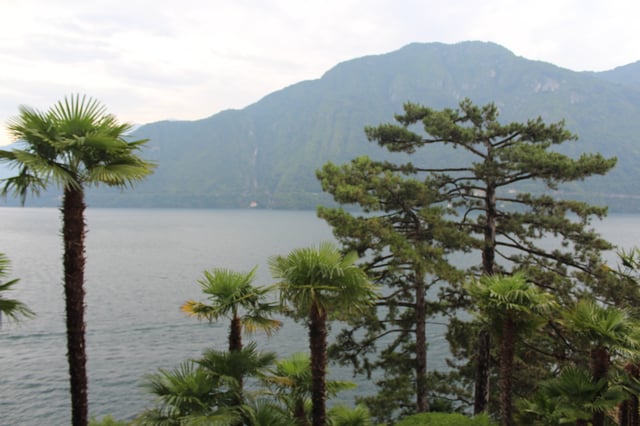
Palms and maritime pines on the shores of Lake Como
Lombardy has a wide array of climates, due to local variances in elevation, proximity to inland water basins, and large metropolitan areas.
The climate of the region is mainly humid subtropical (Köppen Cfa), especially in the plains, though with significant variations to the Köppen model especially regarding the winter season, that in Lombardy is normally long, damp and rather cold. In addition, there is a high seasonal temperature variation (in Milan, the average January temperature is 2.5 °C (36.5 °F) and 24 °C (75 °F) in July). A peculiarity of the regional climate is the thick fog that covers the plains between October and February.
In the Alpine foothills, characterised by an oceanic climate (Köppen Cfb), numerous lakes exercise a mitigating influence, allowing the cultivation of typically Mediterranean crops (olives, citrus fruit).
In the hills and mountains, the climate is humid continental (Köppen Dfb). In the valleys it is relatively mild, while it can be severely cold above 1,500 metres, with copious snowfalls.
Precipitation is more intense in the Prealpine zone, up to 1,500 to 2,000 mm (59.1 to 78.7 in) annually, but is abundant also in the plains and alpine zones, with an average of 600 to 850 mm (23.6 to 33.5 in) annually. The total annual rainfall is on average 827 mm.[10]
History
Prehistory and antiquity
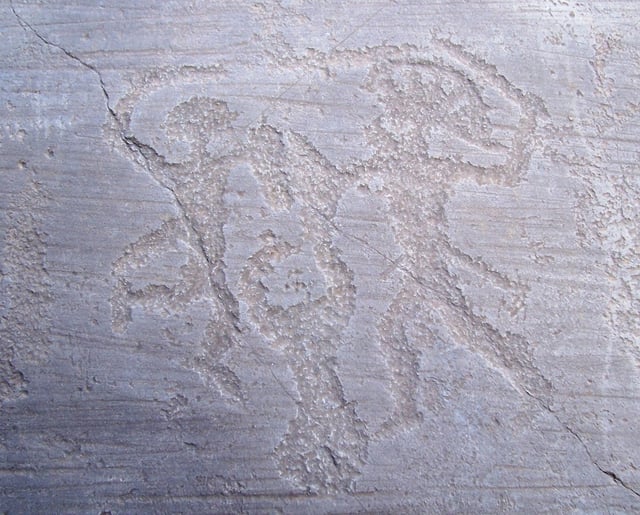
The Rock Drawings in Valcamonica are among the largest collections of prehistoric petroglyphs in the world.[11]
The area of current Lombardy was settled at least since the 2nd millennium BC, as shown by the archaeological findings of ceramics, arrows, axes and carved stones. Well-preserved rock drawings left by ancient Camuni in the Valcamonica depicting animals, people and symbols were made over a time period of eight thousand years preceding the Iron Age,[12] based on about 300,000 records.[13]
The many artifacts (pottery, personal items and weapons) found in necropolis near the Lake Maggiore, and Lake Ticino demonstrate the presence of the Golasecca Bronze Age culture that prospered in Western Lombardy between the 9th and the 4th century BC.
In the following centuries it was inhabited by different peoples among whom the Etruscans, who founded the city of Mantua and spread the use of writing; later, starting from the 5th century BC, the area was invaded by Celtic–Gallic tribes. These people settled in several cities (including Milan) and extended their rule to the Adriatic Sea.
Their development was halted by the Roman expansion in the Po Valley from the 3rd century BC onwards. After centuries of struggle, in 194 BC the entire area of what is now Lombardy became a Roman province with the name of Gallia Cisalpina ("Gaul on the inner side (with respect to Rome) of the Alps").
The Roman culture and language overwhelmed the former civilisation in the following years, and Lombardy became one of the most developed and rich areas of Italy with the construction of a wide array of roads and the development of agriculture and trade. Important figures like Pliny the Elder (in Como) and Virgil (in Mantua) were born here. In late antiquity the strategic role of Lombardy was emphasised by the temporary moving of the capital of the Western Empire to Mediolanum (Milan). Here, in 313 AD, Roman Emperor Constantine issued the famous Edict of Milan that gave freedom of confession to all religions within the Roman Empire.
Kingdom of the Lombards

The Iron Crown of Lombardy has been for centuries used in the Coronation of the Holy Roman Emperor.
During and after the fall of the Western Empire, Lombardy suffered heavily from destruction brought about by a series of invasions by tribal peoples. The last and most effective was that of the Germanic Lombards, or Longobardi, whose whole nation migrated here from the Carpathian basin in fear of the conquering Pannonian Avars in 568 and whose long-lasting reign (with its capital in Pavia) gave the current name to the region. There was a close relationship between the Frankish, Bavarian and Lombard nobility for many centuries.
After the initial struggles, relationships between the Lombard people and the Latin-speaking people improved. In the end, the Lombard language and culture assimilated with the Latin culture, leaving evidence in many names, the legal code and laws, and other things. The genes of the Lombards became quickly diluted into the Italian population owing to their relatively small number and their geographic dispersal in order to rule and administer their kingdom.[14] The end of Lombard rule came in 774, when the Frankish king Charlemagne conquered Pavia, deposed Desiderius, the last Lombard king, and annexed the Kingdom of Italy (mostly northern and central present-day Italy) to his empire. The former Lombard dukes and nobles were replaced by other German vassals, prince-bishops or marquises.
Communes and the Empire
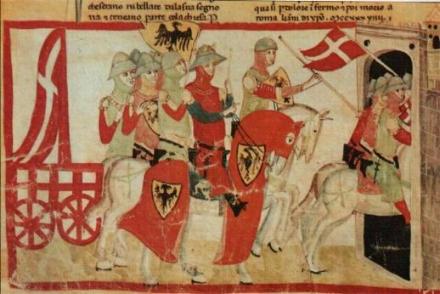
Battle of Cortenuova, 1237.
In the 10th century Lombardy, formally under the rule of the Holy Roman Empire, like much of central-northern Italy, was in fact divided in a multiplicity of small, autonomous city-states, the medieval communes. The 11th century marked a significant boom in the region's economy, due to improved trading and, mostly, agricultural conditions, with arms manufacture a significant factor. In a similar way to other areas of Italy, this led to a growing self-acknowledgement of the cities, whose increasing richness made them able to defy the traditional feudal supreme power, represented by the German emperors and their local legates. This process reached its apex in the 12th and 13th centuries, when different Lombard Leagues formed by allied cities of Lombardy, usually led by Milan, managed to defeat the Hohenstaufen Emperor Frederick I, at Legnano, and his grandson Frederick II, at Parma. Subsequently, among the various local city-states, a process of consolidation took place, and by the end of the 14th century, two signorias emerged as rival hegemons in Lombardy: Milan and Mantua.
Renaissance duchies of Milan and Mantua
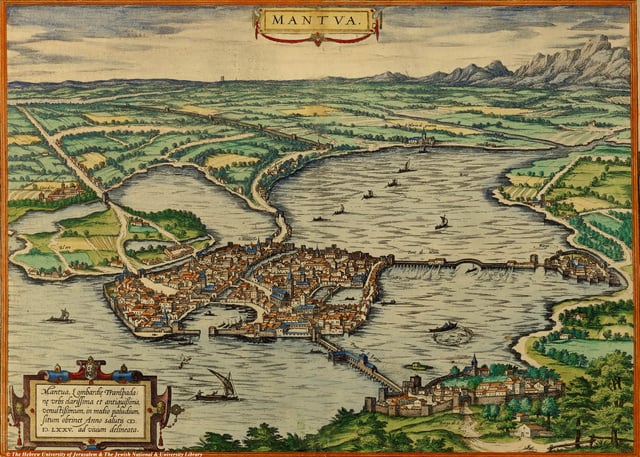
Mantua as it appeared in 1575.
In the 15th century the Duchy of Milan was a major political, economical and military force at the European level. Milan and Mantua became two centres of the Renaissance whose culture, with men such as Leonardo da Vinci and Mantegna, and works of art were highly regarded (for example, Leonardo da Vinci's The Last Supper). The enterprising class of the communes extended its trade and banking activities well into northern Europe: "Lombard" designated the merchant or banker coming from northern Italy (see, for instance, Lombard Street in London). The name "Lombardy" came to designate the whole of Northern Italy until the 15th century and sometimes later. From the 14th century onwards, the instability created by the unceasing internal and external struggles ended in the creation of noble seigniories, the most significant of which were those of the Viscontis (later Sforzas) in Milan and of the Gonzagas in Mantua. This richness, however, attracted the now more organised armies of national powers such as France and Austria, which waged a lengthy battle for Lombardy in the late 15th to early 16th centuries.
Late-Middle Ages, Renaissance and Enlightenment

The Consulta of the République cisalpine receives the First Consul on 26 January 1802
After the decisive Battle of Pavia, the Duchy of Milan became a possession of the Habsburgs of Spain: the new rulers did little to improve the economy of Lombardy, instead imposing a growing series of taxes needed to support their unending series of European wars. The eastern part of modern Lombardy, with cities like Bergamo and Brescia, was under the Republic of Venice, which had begun to extend its influence in the area from the 14th century onwards (see also Italian Wars). Between the middle of the 15th century and the battle of Marignano in 1515, the northern part of east Lombardy from Airolo to Chiasso (modern Ticino), and the Valtellina valley came under possession of the old Swiss Confederacy.
Pestilences (like that of 1628/1630,[15] described by Alessandro Manzoni in his I Promessi Sposi) and the generally declining conditions of Italy's economy in the 17th and 18th centuries halted the further development of Lombardy. In 1706 the Austrians came to power and introduced some economic and social measures which granted a certain recovery.
Austrian rule was interrupted in the late 18th century by the French armies; under Napoleon, Lombardy became the centre of the Cisalpine Republic and of the Kingdom of Italy, both being puppet states of France's First Empire, having Milan as capital and Napoleon as head of state. During this period Lombardy took back Valtellina from Switzerland.
Modern era
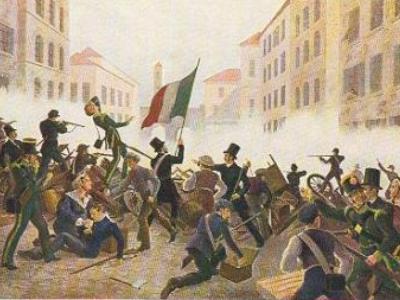
The Five Days of Milan, 1848.
The restoration of Austrian rule in 1815, as the Kingdom of Lombardy–Venetia, was characterised by the struggle with the new ideals introduced by the Napoleonic era.
The popular republic established by the 1848 revolution was short-lived, its suppression leading to renewed Austrian rule. This came to a decisive end when Lombardy was annexed to the Kingdom of Italy 1859 as a result of the Second Italian Independence War. When annexed to the Kingdom of Italy in 1859 Lombardy achieved its present-day territorial shape by adding the Oltrepò Pavese (formerly the southern part of Novara's Province) to the province of Pavia.
Demographics
| Historical population | ||
|---|---|---|
| Year | Pop. | ±% |
| 1861 | 3,160,000 | — |
| 1871 | 3,529,000 | +11.7% |
| 1881 | 3,730,000 | +5.7% |
| 1901 | 4,314,000 | +15.7% |
| 1911 | 4,889,000 | +13.3% |
| 1921 | 5,186,000 | +6.1% |
| 1931 | 5,596,000 | +7.9% |
| 1936 | 5,836,000 | +4.3% |
| 1951 | 6,566,000 | +12.5% |
| 1961 | 7,406,000 | +12.8% |
| 1971 | 8,543,000 | +15.4% |
| 1981 | 8,892,000 | +4.1% |
| 1991 | 8,856,000 | −0.4% |
| 2001 | 9,033,000 | +2.0% |
| 2011 | 9,704,151 | +7.4% |
| 2018 (est.) | 10,049,100 | +3.6% |
| Source: ISTAT 2017 | ||
One-sixth of the Italian population or about 10 million people live in Lombardy (16.2% of the national population; 2% of the European Union population), making it the second most densely populated region in Italy after Campania.
The population is highly concentrated in the Milan metropolitan area (2,000 inh./km2) and the Alpine foothills that compose the southern section of the provinces of Varese, Como, Lecco, Monza and Brianza and Bergamo, (1,200 inh./km2). A lower average population density (250 inh./km2) is found in the Po valley and the lower Brescia valleys; much lower densities (less than 60 inh./km2) characterise the northern mountain areas and the southern Oltrepò Pavese subregion.[17]
The growth of the regional population was particularly sustained during the 1950s–60s, thanks to a prolonged economic boom, high birth rates, and strong migration inflows (especially from Southern Italy). Since the 1980s, Lombardy has become the destination of a large number of international migrants, insomuch that today more than a quarter of all foreign-born residents in Italy lives in this region. As of 2016, the Italian national institute of statistics (ISTAT) estimated that 1,139,430 foreign-born immigrants live in Lombardy, equal to 11.4% of the total population. The primary religion is Catholicism; significant religious minorities include Christian Waldenses, Protestants and Orthodox, as well as Jews, Sikh and Muslims.
Economy
As of 2013, the gross domestic product (GDP) of Lombardy, equal to over €350 billion, accounts for about 21% of the total GDP of Italy. When this measure is considered by inhabitant, it results in a value of €33,066 per inhabitant, which is more than 25% higher than the national average of €25,729.[17]
| 2000 | 2001 | 2002 | 2003 | 2004 | 2005 | 2006 | 2007 | 2008 | 2009 | 2010 | 2011 | 2012 | 2013 | 2014 | 2015 | |
|---|---|---|---|---|---|---|---|---|---|---|---|---|---|---|---|---|
| GDP (euro)[19] | 247.051,8 | 259.431,0 | 270.653,3 | 279.450,4 | 289.471,2 | 297.600,4 | 307.717,7 | 320.843,8 | 323.973,3 | 310.952,0 | 346.797 | 354.342 | 348.665,0 | 349.008,0 | 350.025 | 357.200 |
| GDP per capita[20] (Euro) | 27.488,1 | 28.765,6 | 29.836,9 | 30.448,8 | 31.059,5 | 31.545,2 | 32.356,3 | 33.442,5 | 33.424,8 | 31.743,1 | 35.712,55 | 36.220,23 | 35.367,31 | 35.126,67 | 35.044,17 | 35.700 |
Lombardy's development has been marked by the growth of the services sector since the 1980s, and in particular by the growth of innovative activities in the sector of services to enterprises and in credit and financial services. At the same time, the strong industrial vocation of the region has not suffered. Lombardy remains, in fact, the main industrial area of the country. The presence, and development, of a very high number of enterprises belonging to the services sector represents a favourable situation for the improvement of the efficiency of the productive process, as well as for the growth of the regional economy.
Lombardy has cultural and economical relationships with foreign countries and states which include Azerbaijan,[21] Austria,[22][23][24] France,[25] Hungary,[26][27][28][29][30] the Canton of Ticino and Graubünden in Switzerland,[31][32][33][34] the Province of Quebec in Canada,[35] the States of Bavaria,[36] Saxony[37] and Saxony-Anhalt[38] in Germany, Kuwait[39],the Province of Zuid-Holland in the Netherlands[40], and Russia[41]. Lombardy is a member of the Four Motors of Europe, an Intereuropean economical organization which includes Baden-Wurtenberg in Germany, Catalonia in Spain, and Auvergne-Rhône-Alpes in France.[42] The Lombardy region is part of Eusalp which promotes innovation, green sustainability and economy in the Alpine Regions of Austria, France, Liechtenstein, Northern Italy, Southern Germany, Switzerland, and Slovenia[43][44][45]. Lombardy is also part of ARGE ALP which gathers states located in the alpine regions of Austria, Northern Italy, Southern Germany, and Switzerland to discuss similar themes as in EUSALP[46]. Economical and cultural relationship are also strong with neighboring Italian regions Friuli-Venezia Giulia, South Tyrol, Trentino, and Veneto. [47][48][49][50][51][52][53][54][55][56][57] The European Union has developed the CENTRAL EUROPE program 2014-2020 to foster cooperation in several areas between the Lombardy Region along with other Northern Italian Regions and several states of Central Europe [58][59].
The region can broadly be divided into three areas as regards the productive activity. Milan, where the services sector makes up for 65.3% of the employment; a group of provinces, Varese, Como, Lecco, Monza and Brianza, Bergamo and Brescia, highly industrialised, although in the two latter ones, in the plains, there is also a rich agricultural sector. Finally, in the provinces of Sondrio, Pavia, Cremona, Mantova and Lodi, there is a consistent agricultural activity, and at the same time an above average development of the services sector.
The productivity of agriculture is enhanced by a well-developed use of fertilisers and the traditional abundance of water, boosted since the Middle Ages by the construction (partly designed by Leonardo da Vinci) of a wide net of irrigation systems. Lower plains are characterised by fodder crops, which are mowed up to eight times a year, cereals (rice, wheat and maize) and sugar beet. Productions of the higher plains include cereals, vegetables, fruit trees and mulberries. The higher areas, up to the Prealps and Alps sectors of the north, produce fruit and wine. Cattle (with the highest density in Italy), pigs and sheep are raised.
The unemployment rate stood at 6.0% in 2018. Regional unemployment was one of the lowest in Italy.[60]
| Year | 2006 | 2007 | 2008 | 2009 | 2010 | 2011 | 2012 | 2013 | 2014 | 2015 | 2016 | 2017 | 2018 |
|---|---|---|---|---|---|---|---|---|---|---|---|---|---|
| unemployment rate (in %) | 3.7% | 3.4% | 3.7% | 5.3% | 5.5% | 5.7% | 7.4% | 8.0% | 8.2% | 7.9% | 7.4% | 6.4% | 6.0% |
Government and politics
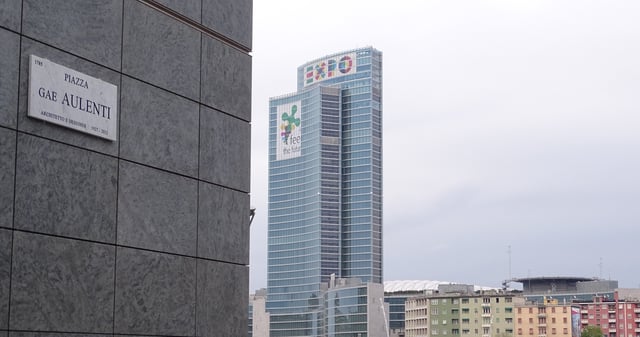
The Palazzo Lombardia, it is the main seat of the government of Lombardy.
Politics in Lombardy is framed within a system of representative democracy, where the President of the Region (Presidente della Regione) is the head of government, and of a pluriform multi-party system. Executive power is vested in the Regional Government (Giunta Regionale). Legislative power is vested in the Regional Council (Consiglio Regionale).
Historically, the moderate Christian Democrats maintained a large majority of the popular support and the control of the most important cities and provinces from the end of the Second World War to the early 1990s. The opposition Italian Communist Party was a considerable presence only in southern Lombardy and in the working class districts of Milan; their base, however, was increasingly eroded by the rival centrist Italian Socialist Party, until eventually the Mani Pulite corruption scandal (which spread from Milan to the whole of Italy) wiped away the old political class and parties almost entirely.
This, together with the general disaffection towards the central government (considered as wasting resources to balance the budgets of the chronically underdeveloped regions of Southern Italy), led to the sudden growth of the secessionist Northern League, particularly strong in mountain and rural areas. In the last twenty years, Lombardy stayed as a conservative stronghold, overwhelmingly voting for Silvio Berlusconi in all the six last general elections. Notwithstanding, the capital city of Milan elected progressive Giuliano Pisapia at the 2011 municipal elections and the 2013 regional elections saw a narrow victory for the center-right coalition.
Administrative divisions
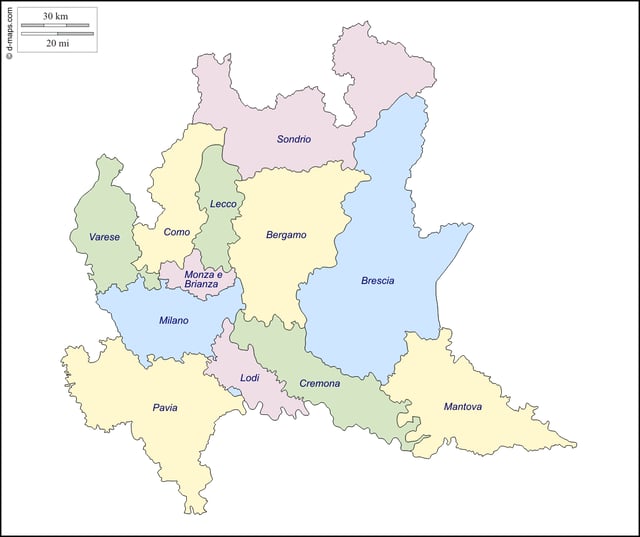
The provinces/metropolitan cities of Lombardy
The region of Lombardy is divided in 11 administrative provinces, 1 metropolitan city and 1,530 communes.
| Province/Metropolitan city | Area (km2) | Population | Density (inh./km2) |
|---|---|---|---|
| Province of Bergamo | 2,723 | 1,108,853 | 407.2 |
| Province of Brescia | 4,784 | 1,265,077 | 264.4 |
| Province of Como | 1,288 | 599,905 | 465.7 |
| Province of Cremona | 1,772 | 361,610 | 204.4 |
| Province of Lecco | 816 | 340,251 | 416.9 |
| Province of Lodi | 782 | 229,576 | 293.5 |
| Province of Mantua | 2,339 | 414,919 | 177.3 |
| Metropolitan City of Milan | 1,575 | 3,196,825 | 2,029.7 |
| Province of Monza and Brianza | 405 | 864,557 | 2,134.7 |
| Province of Pavia | 2,965 | 548,722 | 185.1 |
| Province of Sondrio | 3,212 | 182,086 | 56.6 |
| Province of Varese | 1,211 | 890,234 | 735.1 |
Culture
Beside being an economic and industrial powerhouse, Lombardy has a rich and diverse cultural heritage. The many examples range from prehistory to the present day, through the Roman period and the Renaissance and can be found both in museums and churches that enrich cities and towns around the region. Major tourist destinations in the region include (in order of arrivals as of 2013)[63] the historic, cultural and artistic cities of Milan (4,527,889 arrivals), Bergamo (242,942), Brescia (229,710), Como (215,320), Varese (107,442), Mantua (88,902), Monza (75,839) and the lakes of Garda (429,376), Como (322,585), Iseo (123,337) and Maggiore (71,055).
UNESCO World Heritage Sites
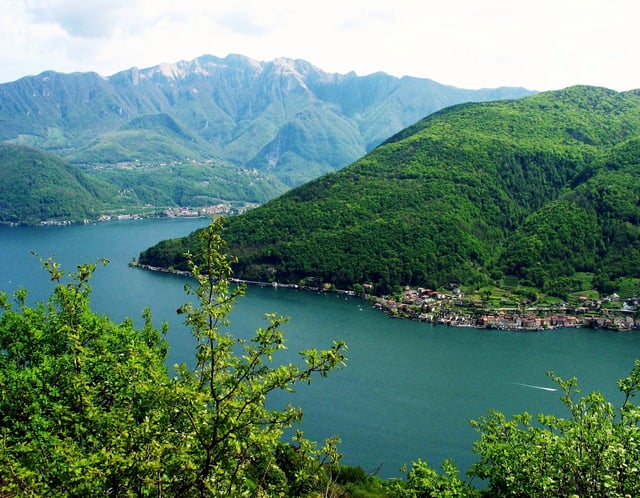
Monte San Giorgio (right) seen across Lake Lugano
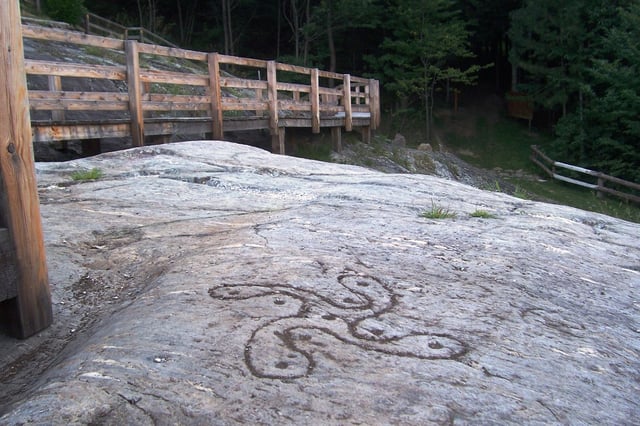
The Rock Drawings in Valcamonica
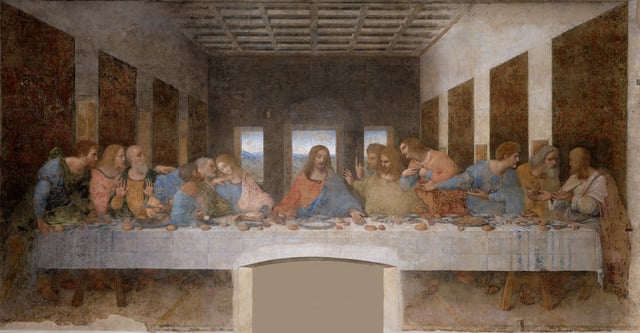
The Last Supper (Convent of Sta. Maria delle Grazie, Milan, Italy (1499), by Leonardo da Vinci)
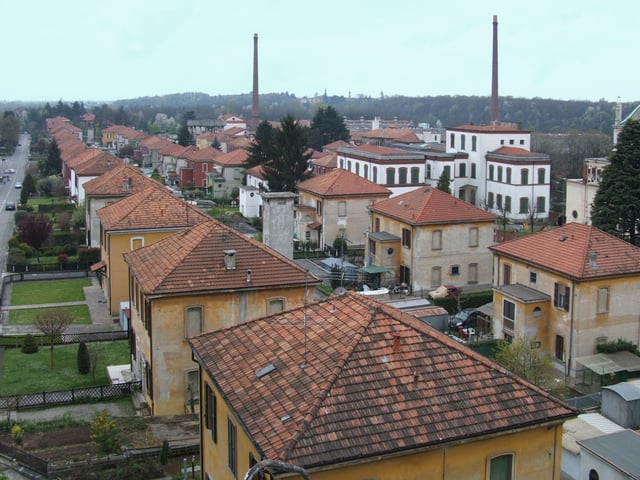
Company houses and the textile mill at Crespi d'Adda, Bergamo province
There are nine UNESCO World Heritage sites wholly or partially located in Lombardy.[64] Some of these comprise several individual objects in different locations. One of the entries has been listed as natural heritage, the others are cultural heritage sites.
At Monte San Giorgio, on the border with Swiss canton Ticino just south of Lake Lugano, a wide range of marine Triassic fossils have been found. During that period, some 240 million years ago, the area was a shallow tropical lagoon. Fossils include reptiles, fish and crustaceans but also some insects.
Two sites are of pre-historic origin. The Rock Drawings in Valcamonica date back to a period between 8000 BC and 1000 BC, covering prehistoric periods from the Epipaleolithic/Mesolithic to the Iron Age. The engravings show depictions of a wide range of topics including agricultural and war scenes alongside more abstract symbols. The multi-centred heritage site Prehistoric pile dwellings around the Alps includes 111 individual objects in France, Switzerland, Italy, Germany, Austria and Slovenia, of which ten are located in Lombardy. Each of these objects consists of remnants of buildings erected on wooden piles in sub-alpine rivers, lakes and wetlands, built between 5000 BC and 500 BC. In general, only the submerged wooden parts have been preserved in the alluvial sediment, although in some places pile buildings have been reconstructed.
Another multi-centred site, Longobards in Italy, Places of Power (568–774 A.D.), comprises seven locations across mainland Italy which illustrate the history of the Lombard period which has given the region its name. Two of the individual sites are in the modern region of Lombardy: the fortifications (the castrum and the Torba tower) and the church of Santa Maria foris portas ("outside the gates") with its Byzantinesque frescoes at Castelseprio, and the monastic complex of San Salvatore-Santa Giulia at Brescia. The UNESCO site of Brescia also includes the remains of its Roman forum, the best-preserved in Northern Italy.[65][66]
The Church and Dominican Convent of Santa Maria delle Grazie in Milan with "The Last Supper" by Leonardo da Vinci represent architectural and painting styles of the Renaissance period of the 15th century. The towns of Mantua and Sabbioneta are also listed as a combined World Heritage site relating to this period, here focussing more on town planning aspects of the time than on architectural detail. While Mantua was rebuilt in the 15th and 16th centuries, according to Renaissance principles, Sabbioneta was planned as a new town in the 16th century.
The Sacri Monti of Piedmont and Lombardy are a group of nine sites in northwest Italy, two of them in Lombardy. The concept of holy mountains can also be found elsewhere in Europe. These sites were created as centres of pilgrimage by placing chapels in the natural landscape and were loosely modelled on the topography of Jerusalem. In Lombardy, Sacro Monte del Rosario di Varese and Sacro Monte della Beata Vergine del Soccorso, built in the early to mid-17th century, mark the architectural transition from the late Renaissance to the Baroque style.
Crespi d'Adda is a company town founded in 1878 to accommodate workers of the local textile mill. At its height, the town was home to 3,200 employees and their families.
The Rhaetian Railway in the Albula/Bernina Landscapes is mostly located in the Swiss canton Graubünden but also extends over the border in Tirano. The site is listed because of the complex railway engineering (tunnels, viaducts and avalanche galleries) necessary to take the narrow-gauge railway across the main chain of the Alps. The two railway lines were opened in stages between 1904 and 1910.
The Venetian Works of Defence between the 16th and 17th centuries: Stato da Terra – western Stato da Mar is a transnational system of fortifications built by the Republic of Venice on its mainland domains (Stato da Terra) and its territories stretching along the Adriatic coast (Stato da Mar). This site includes the Fortified City of Bergamo.
Museums
Lombardy contains numerous museums (over 330) of different types: ethnographic, historical, technical-scientific, artistic and naturalistic which testify to the historical-cultural and artistic development of the region. Among the most famous ones are the National Museum of Science and Technology "Leonardo da Vinci" (Milan), the Accademia Carrara (Bergamo), the Mille Miglia and the Santa Giulia Museum (Brescia), the Volta Temple and the Villa Olmo in Como, the Stradivari Museum (Cremona), the Palazzo Te (Mantua), the Museum Sacred Art of the Nativity and the basilica of Santa Maria Assunta at Gandino, and the Royal Villa of Monza.
Other sights
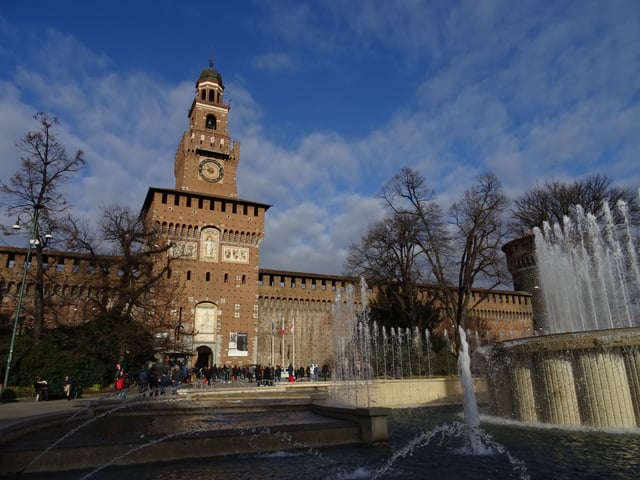
The Sforza Castle
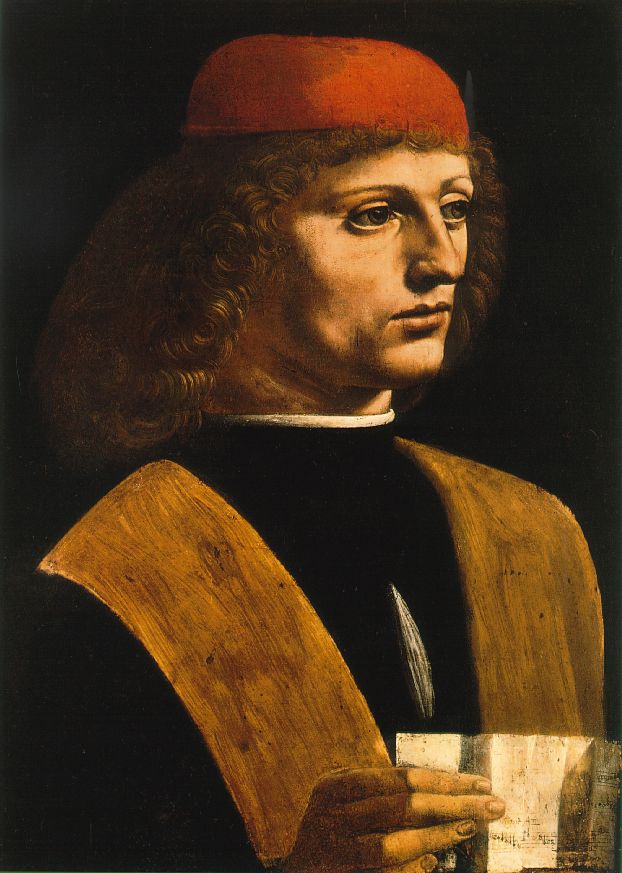
The Portrait of a Musician, oil on wood painting by Leonardo da Vinci.
Cathedral of Milan
Castello Sforzesco, Milan
Basilica di Sant'Ambrogio, Milan
Teatro alla Scala, Milan
Basilica of San Lorenzo, Milan
Basilica of Sant'Eustorgio, Milan
Brera Gallery, Milan
Bellagio
Accademia Carrara, Bergamo
Santa Maria Maggiore and Cappella Colleoni, Bergamo
The fortified Venetian walls, Bergamo
Roman and Longobard monuments in Brescia
Duomo Nuovo, Brescia
Castelseprio archaeological site
Certosa di Pavia
Como Cathedral and Basilica of Sant'Abbondio, Como
Duomo and Torrazzo, Cremona
Lake Como
Lake Garda
Lake Iseo
Tempio Civico della Beata Vergine Incoronata, Lodi
Royal Villa of Monza
San Pietro in Ciel d'Oro and San Michele Maggiore, Pavia
Cuisine
Rice is popular in the region, often found in soups as well as risotti, such as "risotto alla milanese", with saffron. In the city of Monza a popular recipe also adds pieces of sausages to the risotto. Polenta is also common in the all region. Regional cheeses include Robiola, Crescenza, Taleggio, Gorgonzola and Grana Padano (the plains of central and southern Lombardy allow intensive cattle-raising). Butter and cream are used. Single pot dishes, which take less work to prepare, are popular. In Brescia, but mostly in Bergamo, Casoncelli are common. In Valtellina, Pizzoccheri is common, also. In Mantua, festivals feature tortelli di zucca (ravioli with pumpkin filling) accompanied by melted butter and followed by turkey stuffed with chicken or other stewed meats.[67] Among regional typical desserts, there is Nocciolini di Canzo—dry biscuits.
Typical dishes

A traditional "Cotoletta alla milanese (Milanese-style cutlet)" served with potatoes.
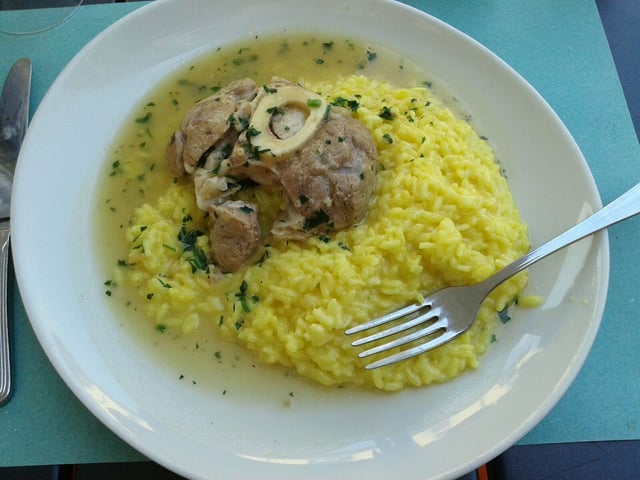
Risotto alla milanese with ossobuco.
Casoncelli
Carpaccio di Bresaola
Pizzoccheri (tagliatelle of buckwheat and wheat, laced with butter, green vegetables, potatoes, sage and garlic, topped with Casera cheese)
Risotto alla milanese
Tortelli di zucca (pumpkin-filled pasta)
Polenta
Ossobuco
Cotoletta (cutlet) alla milanese
Cassoeula
Lo Spiedo Bresciano – spit roast of different cuts of meat with butter and sage
Salamella (Italian Sausage without fennel or anise, always served grilled)
Salame d'oca di Mortara (goose salami)
Gorgonzola cheese
Taleggio cheese
Stracchino cheese
Bitto cheese
Rosa Camuna cheese
Grana Padano cheese
Quartirolo lombardo
Mascarpone
Panettone
Sbrisolona cake
Amaretti di Saronno
Wines
Franciacorta
Nebbiolo red
Bellavista
Santi
Nino Negri
Bonarda Lombardy
Inferno (Valtellina)
Grumello (Valtellina)
Sassella (Valtellina)
Music
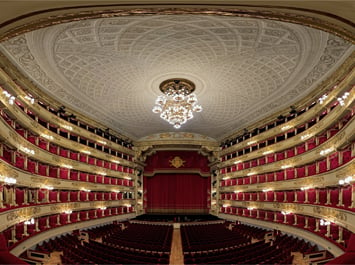
The auditorium of the Teatro alla Scala in Milan.
Besides Milan, the region of Lombardy has 11 other provinces, most of them with equally great musical traditions. Bergamo is famous for being the birthplace of Gaetano Donizetti and home of the Teatro Donizetti; Brescia is hosts the impressive 1709 Teatro Grande; Cremona is regarded as the birthplace of the commonly used violin, and is home to several of the most prestigious luthiers in the world, and Mantua was one of the founding and most important cities in 16th- and 17th-century opera and classical music.
Other cities such as Lecco, Lodi, Varese and Pavia also have rich musical traditions, but Milan is the hub and centre of the Lombard musical scene. It was the workplace of Giuseppe Verdi, one of the most famous and influential opera composers of the 19th century, and boasts a variety of acclaimed theatres, such as the Piccolo Teatro and the Teatro Arcimboldi; however, the most famous is the 1778 Teatro alla Scala, one of the most important and prestigious operahouses in the world.
Language
In Lombardy there is widespread use of Lombard, which exists in diglossia with Italian. Lombard is a language[68] belonging to the Gallo-Italic group, within the Romance languages.[69] It is a cluster of homogeneous varieties used by at least 3,500,000 native speakers in Lombardy and some areas of neighbouring regions, notably the eastern side of Piedmont and Southern Switzerland (cantons of Ticino and Graubünden).[69]
The Lombard language should not be confused with that of the Lombards – Lombardic language – a Germanic language extinct since the Middle Ages.
Fashion
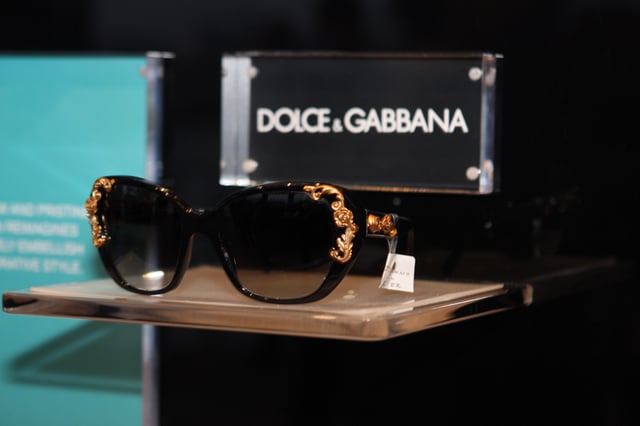
Dolce & Gabbana is headquartered in Milan.
Lombardy has always been an important centre for silk and textile production, notably the cities of Pavia, Vigevano and Cremona, but Milan is the region's most important centre for clothing and high fashion. In 2009, Milan was regarded as the world fashion capital, even surpassing New York, Paris and London.[70] Most of the major Italian fashion brands, such as Valentino, Versace, Prada, Armani and Dolce & Gabbana (to name a few), are currently headquartered in the city.
Sports
The region's city Milan will host the 2026 Winter Olympics alongside Cortina d'Ampezzo.
See also
List of European regions by GDP
2017 Lombard autonomy referendum

